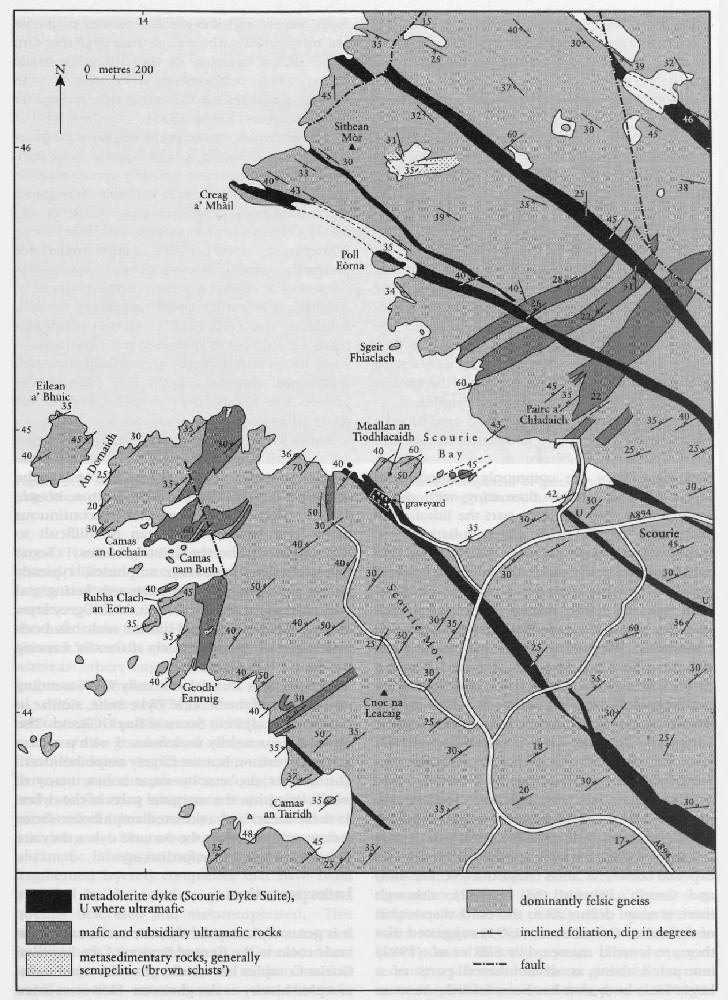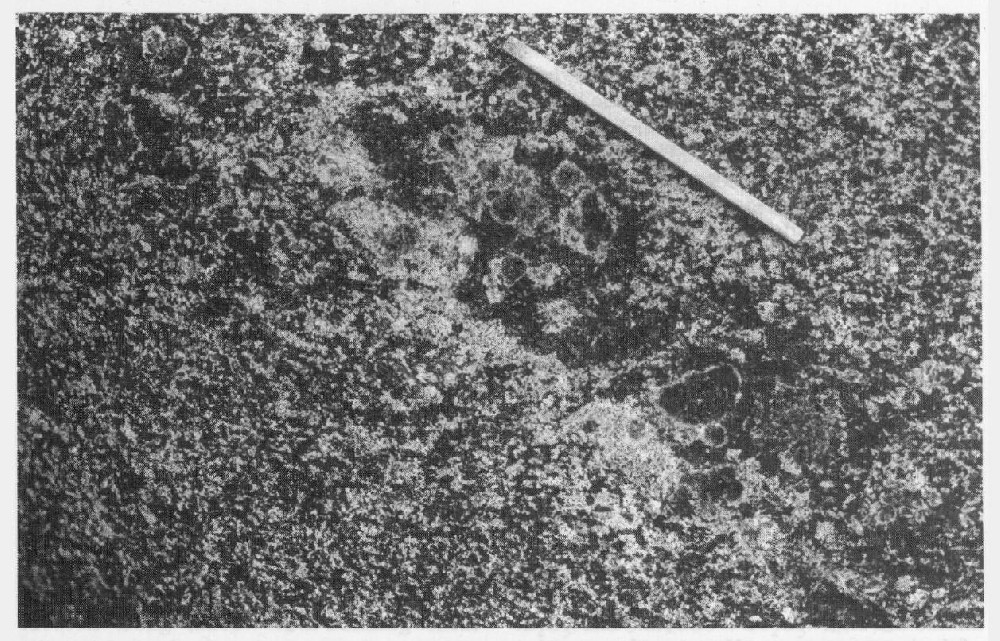Show interactive timeline
Scourie Mor
C.R.L. Friend
Introduction
The rocks on the peninsula of Scourie Mor, which lies south-west of Scourie Bay, form the northern part of the type area for the Central Region of the Lewisian Gneiss Complex (Sutton and Watson, 1951). An extensive array of granulite-facies felsic and mafic gneisses is particularly well displayed between Eilean a' Bhuic
Description
The Scourie Mor GCR site encompasses the peninsula that lies west of the crofts of Scourie Mor, extending from Eilean a' Bhuic to the northwest to Camas an Tairidh to the south-east. The craggy indented coastline and rocky hills that reach 80 m above OD at Cnoc na Leacaig provide excellent clean exposures of the various elements of the Lewisian Gneiss Complex.
The dominant felsic gneisses are broadly tonalitic or dioritic in composition and are typically dark grey-brown in colour on fresh surfaces. They are commonly banded, with layers of felsic gneiss alternating with more-mafic gneiss. For the most part the lithological layering is parallel to a planar foliation, and locally a lineation is present. The layering and foliation generally dip to the north-west at 300–50°. Orthopyroxene, typically associated with garnet, is common throughout the gneisses, signifying granulite-facies metamorphic conditions. Original relationships between the different felsic lithologies have been obscured by the extensive recrystallization and high strain under granulite-facies conditions. The ductile nature of the deformation is indicated by the commonly lineated form of the orthopyroxene and the discontinuous quartz ribbons that partially define the banding and foliation. Low-strain areas are rare, although some localities do occur between Camas an Lochain
Large bodies of mafic–ultramafic rocks are exposed between Camas nam Buth
The ultramafic–mafic rocks display a range of interlayered lithologies, which grade from pure dunite at one extreme through clinopyroxene-and/or orthopyroxene-rich varieties into spinel lherzolites and peridotites (e.g. Peach et al., 1907; O'Hara, 1961a; Savage and Sills, 1980; Whitehouse, 1989). The mafic rocks are generally more homogeneous, commonly consisting of clinopyroxene + orthopyroxene + plagioclase + garnet with accessory spinel, sulphides and Fe-Ti oxides. Garnet porphyroblasts up to 5 cm in diameter are prominent in some layers and normally show plagioclase-rich symplectite coronas
Rocks of supposed metasedimentary origin are rare and occur either in association with the ultramafic–mafic rocks or as parallel bands in the tonalites (e.g. O'Hara, 1960; Burton et al., 1994). They chiefly form thin, discontinuous bands and lenses, which can be difficult to differentiate from the host gneisses. Some bands or lenses contain sulphides, typically pyrite; as a result they are rusty-weathering and stand out more readily. A thin, bluish-grey layer of scapolite-bearing calc-silicate rock has been found east of the mafic body at Geodh' Eanruig (O'Hara, 1960;
The gneisses are cut by broadly WNW-trending mafic dykes of the Scourie Dyke Suite, similar to those in the adjacent Scourie Bay GCR site. The dykes are essentially undeformed with a micro-gabbroic texture, but are largely amphibolitized. The area is also cut by shear zones, many of which lie within the marginal parts of the dykes. As these shears and associated amphibolite-facies metamorphism affect the Scourie dykes they are presumed to be of Laxfordian age.
Interpretation
It is generally accepted that the mafic and ultramafic rocks in the Central Region of the Lewisian Gneiss Complex have undergone the same metamorphic history as the gneisses. However, there have been differing views as to the survival of any remnants of the primary igneous minerals (e.g. O'Hara, 1961a; Savage and Sills, 1980), and several different interpretations regarding the origin and disposition of the mafic-ultramafic masses. O'Hara (1961a, 1965) suggested that the mafic rocks formed by metasomatic reactions between ultramafic material and the host gneisses, whereas others suggested that they represent fragmented layered complexes (e.g. Bowes et al., 1964; Davies, 1974). The latter view was corroborated by Sills et al. (1982), who carried out extensive geochemical analyses, particularly from the units at Camas nam Buth. They demonstrated the presence of cryptic layering and established a consistent way-up based on geochemical criteria, which could be traced over fold hinges. They concluded that the mafic-ultramafic lithologies represent the remains of fragmented layered complexes that have been intruded by the tonalitic gneisses and subsequently deformed and metamorphosed. This model is consistent with other Archaean terrains in the North Atlantic region (e.g. Greenland and Labrador). However, because of the chemical imbalance that exists between the ultramafic and felsic gneisses there are clear areas where limited metasomatic exchange, as proposed by O'Hara (1961a, 1965), can be observed. Whereas many of the relationships between the mafic-ultramafic units and the dominant felsic gneisses are equivocal, there are some low-strain areas that preserve cross-cutting relationships, showing that the protoliths of the felsic gneisses cross-cut the igneous layering in the mafic rocks.
The age of the ultramafic-mafic bodies has been equally controversial. Humphries and Cliff (1982) conducted Sm-Nd mineral studies of metamorphic minerals in these bodies and obtained an age of c.
U-Pb isotope studies of single zircons in granulite-facies tonalitic gneisses from the Scourie Bay area have given protolith ages of c.
Conclusions
The Scourie Mor GCR site provides some of the best examples in the Lewisian Gneiss Complex of Archaean tonalitic felsic gneisses and mafic-ultramafic bodies. Sm-Nd and U-Pb isotopic age dating has shown that the protolith igneous bodies were formed at c.
The site includes several 'low-strain' areas that have undergone very little deformation at all, and the original lithological and geochemical layering is well preserved within some of the mafic-ultramafic rocks. Within these low-strain areas, the host felsic gneisses show good crosscutting relationships, which demonstrate that the mafic and ultramafic bodies are older than the tonalitic felsic gneisses. In other areas such relationships are unclear or contradictory and research is ongoing as to their relative and absolute ages. The site remains one of the best places to study the early history of the Lewisian Gneiss Complex and as such is of international importance.


